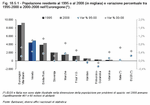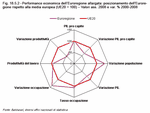An idea by the Presidents of the Veneto, Friuli Venezia Giulia and Carinthia regions to consolidate the natural vocation of their territories to cooperate in a network (Note 1) was the culmination of a desire to act, build new institutional networks geared towards giving impetus to these regions, and create a positive knock-on effect for other European spaces. This move led to
Euroregione senza confini, the Borderless Euroregion project, which was implemented last March on the passing of a Regional Law by Regione Veneto which approved the draft convention for the European Territorial Cooperation Group (ETCG). This convention turned the long-standing cooperation between Veneto and its neighbouring regions Friuli Venezia Giulia and Carinthia into a stable organisation that has importance for the entire EU; it was officially introduced by the presidents of the three regions in Venezia on 17 November 2009.
The establishment of this institutional network aims to benefit the relations between each territory, which have long been present on account of historical and geographical reasons. In the year 1000, the Serenissima Republic had already established an array of relations with other territories, a skill on which it based its hegemony in trade, especially towards the East.
This cooperation is rooted in the
Villa Manin Euroregion, which was named after a meeting in Villa Manin, Passariano (Friuli Venezia Giulia) on 21 June 2007, when a work-group with the aim of establishing an EGTC was held. The legal basis was the "Protocol of Trilateral Cooperation", signed in Klagenfurt, Austria, on 11 January 2007 by the presidents of the two Italian regions and by the President of Carinthia. The agreement was signed by the three presidents mentioned above, as well as by the presidents of two Croatian counties, Istria and Litoraneo-Montana, and left open for acceptance by Slovenia
(Note 2).
A number of regional interests have been pursued under a common framework: these include production activities, transport infrastructure, agriculture, territorial protection, civil protection, tourism, training, culture, scientific research, innovation and even social healthcare. All of these sectors have set up projects benefitting from EU funds.
The extended Euroregion, which includes not only the areas institutionally involved (Veneto, Friuli Venezia Giulia and Carinthia) but also Slovenia, Istria and Litoraneo-Montana, encompassed 9.2 million people in 2008
(Note 3) of which 4.9 million, i.e. 53%, lived in Veneto. The second largest area in terms of population is Slovenia, where 22% of the Euroregion live. Then come Friuli Venezia Giulia with 13.3% and Carinthia with 6.1%. The counties of Istria and Litoraneo-Montana have a total of 517,000 inhabitants and make up the remaining 5.6% of the Euroregion's population. This is a rough estimate of how the population is distributed between the different areas of the Euroregion.
The demography of the area reveals that there is a low amount of children and young people and that the size of the elderly population is growing. Between 2000 and 2007, the main increase was in the over-80s, but the 40-60 year-old age bracket also grew, which shows that there is a growing availability of an active population. On the other hand, there was a sharp fall in the number of 20-35-year-olds.
All of these regions had fewer children and young people than the European average. In Friuli Venezia Giulia, Istria and Litoraneo-Montana, under-15s made up only 12-13% of the entire population in 2007, whereas the European average was almost 16%; Carinthia and Veneto bring the Euroregion average to 14%. On a positive note, between 2000 and 2007 the Italian regions saw their population of young people increase; however it diminished in the other regions and in Europe
(Figure 18.5.1).
Population growth in the Euroregion is being driven by Veneto which, alongside Emilia Romagna and other Italian regions, has seen a notable increase in immigration over the last decade. It seems that Europe's Mediterranean countries are becoming more attractive to foreign labour, which has enabled them to bridge the gap, at least partly, between Europe's traditional destinations for immigration in recent decades
(Figure 18.5.2).
The Euroregion has a rate of economic development similar to the European average: GDP per capita is almost the same, labour productivity is only 6% below the European average, while the employment rate is 6% higher. This near parity with the European average is mainly due to the level of well-being in the Italian and Austrian areas of the Euroregion, while the strength of the economy in Slovenia and the Croatian counties is weaker.
Growth, however, shows a different situation: the Euroregion is ahead of the European average for population and employment growth, but it is behind in terms of GDP growth and productivity. Its performance is influenced by the trend within the Italian regions, which between 2000 and 2008 showed strong population growth, but a lower-than-average growth in GDP. Growth in the GDP of Italian regions was purely an effect of the increase in employment, but there was, however, a fall in productivity. On the other hand, Slovenia and the Croatian counties are bounding towards the levels of well-being and productivity in Western Europe, but they have less of an effect on the Euroregion. The Euroregion, a cross-border institutional network much needed within European space, is a balancing act, and it requires growth to be given a boost, especially in certain areas. We do not yet know if this is the optimum size of the Euroregion in institutional terms; but we can certainly say the network that has been set up is a cornerstone on which to build plans to face the major transformations that are taking place
(Note 4).






